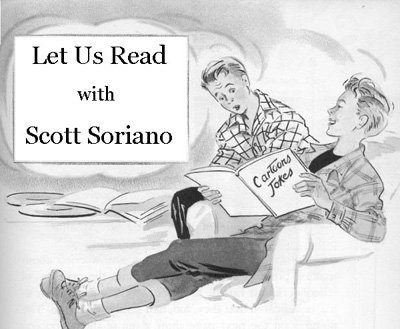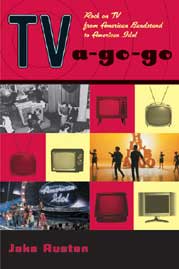
Jake Austen. TV A-Go-Go: Rock on TV from American Band Stand to American Idol. Chicago Review Press, 2005 (www.ipgbook.com)
Within the culture of music fans there are those who crave authenticity and those who could give two shits about it. I am one of those who look for the raw and real in music. Though I do enjoy the odd heavily crafted, well planned out, synthetic pop song, done by a gang of pay check pullers (after all, who can pass up a good bubblegum song?), I�d rather stumble upon a record recorded by some crazy hick, possessed by the need to put his music out there. Give me five kids who don�t know that rock & roll has rules over a group of seasoned music vets any day. If you are reading this, I am sure you probably feel the same.
Sometimes a medium emerges that seems to be antithetical to authenticity. Television is such an example. TV is synthetic, it demands artificial, and it is responsible for a mass consumer culture that craves shallowness and not the raw and real. In TV A-Go-Go, Jake Austen, editor of Roctober zine, writes that maybe TV does demand inauthenticity and maybe it doesn't. He reports that, while most of what is presented on TV is exactly what its critics charge, there are individual cases where authenticity does shine through. More important, TV has an audience and that audience has authentic reactions to what it sees. Austen has written TV A-Go-Go with this understanding.
When I look back on my reaction to seeing rock & roll on TV, I can relate to Austen�s point of view. I never was an American Bandstand or Soul Train fan when I was a kid and Midnight Special was on too late for young Scott. However, when I became a teen and fell into punk rock, television had a profound impact on me and my peers. The three earliest rock & roll television moments that I remember are the performances of Elvis Costello and Devo on Saturday Night Live and John Lydon/Rotten and PiL on Tom Snyder�s Tomorrow show.
Elvis Costello�s 1977 SNL performance was the first time I saw anything close to punk rock being played on the TV set. At the time it was riveting. Here was a skinny, geeky guy who was obviously angry, playing tense spare rock & roll. Costello starts a song, only to wave it off and go into another which he was told not to play was exactly the opposite of the polished, show biz rock I was so accustom to seeing on variety shows like Sonny & Cher and The Glen Campbell Show.
I was already into punk rock when Devo took the SNL stage in 1978. My copies of 'Never Mind the Bollocks' and 'Pure Mania' were well worn by then and I thought I was punk as piss. Then I saw Devo. Again my head swirled. The next day at school, my friend Deathrider and I compared notes and imitated the jerky, violent, grand mal motions that we saw the night before. Devo on SNL made us want to form a band and break things.
Two years later, on the Tomorrow Show, Tom Snyder sat down with Public Image�s John Lydon and talked. Until then, other than a few music performances, the only punk rock I saw on TV was some punk yelling something brilliant like �Gable morggle borgle boog.� Lydon was the first smart punk rocker I had seen on TV. As a bright teenage punk rocker, seeing Lydon on Tomorrow was a validation. Though instinctively I already knew it, that TV moment told me that, yes, you can be smart and like punk rock.
Those three moments and their lessons might seem trite and obvious today, but back then, they were not. It was almost a rule that TV was to present punk rock as something dumb, superficial, and violent. Today, the punk rock episodes of CHiPs and Quincy seem campy (and they were amusing then) but back in the early 1980s they just reinforced the Christian/Parent/Cop line that punk rock was evil and must be abolished by any means necessary. Even worse were talk show whores like anti-punk family councilor Serena Dank, who advocated �counter programming� punk kids so that they become productive members of society. All of this served as propaganda used by cops to justify brutality toward punks (we were not human to them) and by parents who forced their punk kids into Christian military schools in places like rural Utah. Sure, shows like Quincy were hokey and totally inauthentic, but the impact they had on their viewers was anything but artificial.

While Austen makes some strong points in his look at punk on TV, punk rock is not the book�s main focus. TV A-Go-Go studies local dance shows, Black television and the presentation of soul music, lip-synching, cartoon & made-for-TV rock bands, the TV variety show, the rise of MTV, and modern day talent contests such as American Idol. All of the subjects are treated in depth and with intelligence. However, just because this book is smart, do not think that it is unreadable. Austen�s first book is not an academic tome. Yes, you could assign it for a class, but it reads like it was written by an informed fan. As a result, TV A-Go-Go not only becomes the best book I have ever read on TV and rock & roll (I�ve read a few), but it deserves shelf space next to other smart, fan-spurred music histories such as Sweet Soul Music and Last Night a DJ Saved my Life. It is a remarkable book.
(And with that I have to disclose that I was interviewed for TV A-Go-Go and am quoted in the book. However, I received no monetary or other compensation for my effort and do not benefit financially from sales of the book.)
-Scott Soriano
To read more of Soriano's various columns go here.
PREVIOUS PAGE � HOME � NEXT PAGE
|

